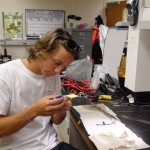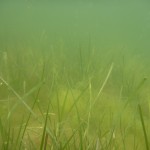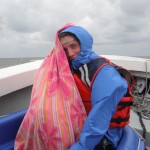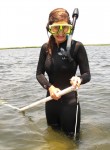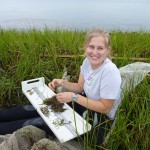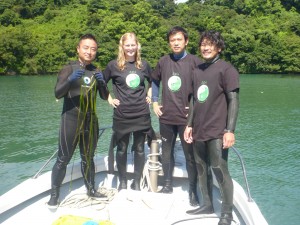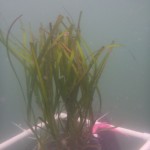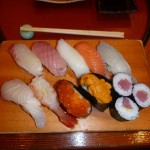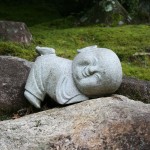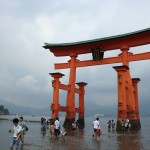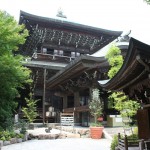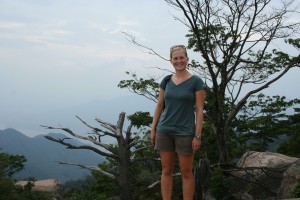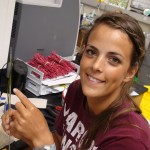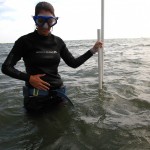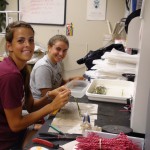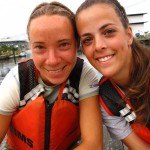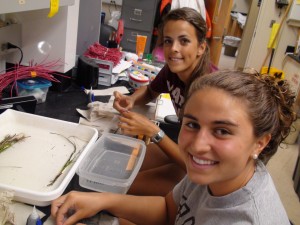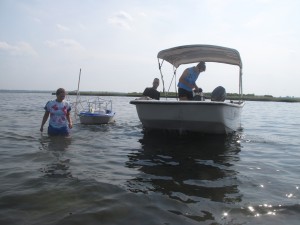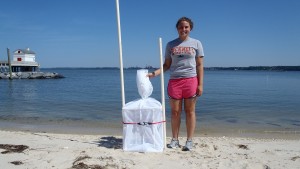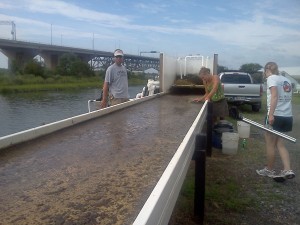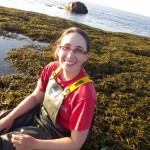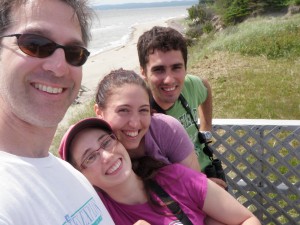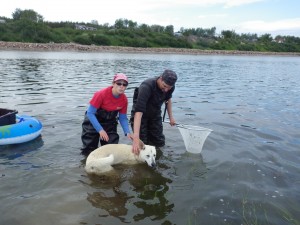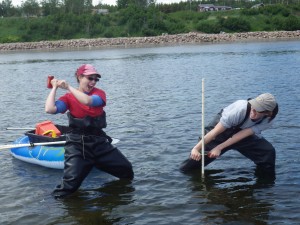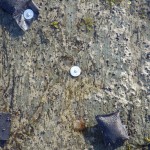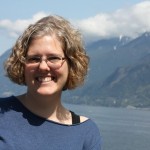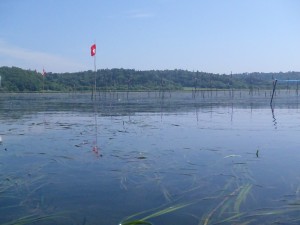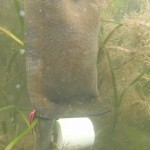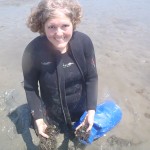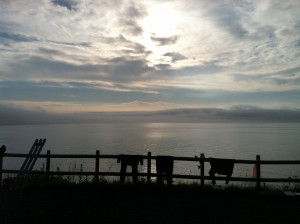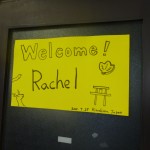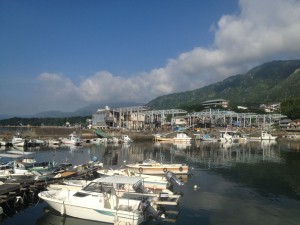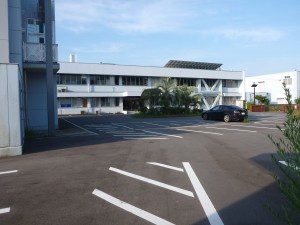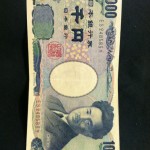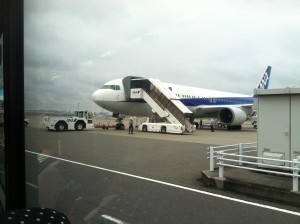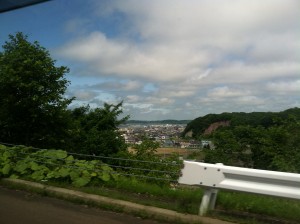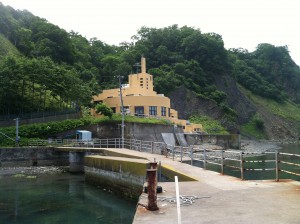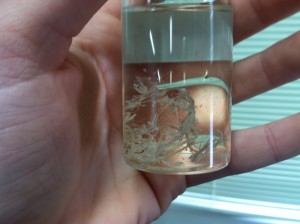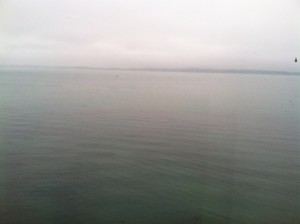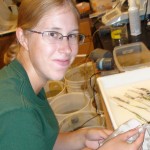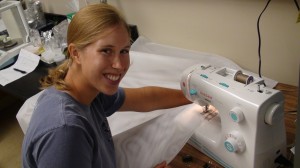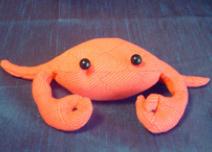The business of science
by John Schengber (VIMS undergraduate student summer intern)
I am an undergraduate at James Madison University and have been working this summer with the ZEN team at the Virginia Institute of Marine Science in Gloucester, Virginia. I have lived right across the river in neighboring Yorktown for most of my life. Surrounded by nature and adventure, I have become an outdoor kind of guy with an intense curiosity and respect for nature. I still have not decided the exact career path I want to take, so this summer was an excellent opportunity to explore research and marine biology.
I think most people in the lab were surprised when I revealed that I am in fact a business major. Everyone else around here studies (go figure) science. In the fall, I will be returning for my sophomore year at James Madison University, where I am pursuing a major in International Business coupled with a double minor in Spanish and Environmental Science. Now, why in the world would a business major be working in a science lab? First, let me emphasize that this career direction is not entirely definitive for me. I am fascinated by a myriad of fields of study. In business, I am drawn to the ideas of entrepreneurship and creativity, but not so much to the possibility of cubicle entrapment. I dream of running my own company, but am conflicted as business/industry can often be a driving force in the destruction of our natural world.
My love for science stems from my love for nature and the questions it begs us to answer. I am in constant awe of its wonder, and my life would be at loss if my studies lacked a good dosage of the biological sciences. Yet I love to interact with people (especially in Spanish), to solve problems, and to try new ideas in the business sector. So, I have come to a crucial intersection of interests. Business seems to be the last thing to enter if one is focused on saving the world from its own ruin. But I wonder if it can be done differently? Can we make a business that is not just sustainable but truly symbiotic with our environment? Most importantly, can this venture be profitable in a cut-throat capitalist economy? Lastly, can I be the person to do this? I have no idea. But I’d say it’s worth a shot.
So here I am at the Virginia Institute of Marine Science taking that first step. I came into this position with a few hopes and expectations. I wanted to check out the work of a marine biologist, which is my greatest love in science and the field that I would most likely enter if I decided to pursue a research career. I hoped that I would meet some incredible people with inspiring intelligence and personalities to match. I wanted to view the process of scientific investigation from beyond classroom instruction or media coverage. I wanted to learn a lot and experience even more. But really I just wanted to hang out with some amphipods.
All of my hopes and expectations have been fulfilled, and I have loved every minute of it. I have made new friends and linked up with old ones (see Nicole Rento’s post, fellow lab member this summer and best friend since, well, forever). I have learned more than I could have ever imagined. I have spent some quality time with lots and lots of amphipods. And I’ve learned that running a lab really isn’t too much different than running a business. There are budgets, deadlines, management, and lots and lots of ingenuity. Maybe there’s hope for me yet.
Calling all undergrads – get your hands on some science!
by Pamela Reynolds (ZEN Coordinator)
Calling all undergraduate students at the College of William and Mary, and surrounding colleges!
The Marine Biodiversity Lab at VIMS has several open positions this fall for research internships in marine ecology, evolution and biodiversity research. Students will receive hands-on research experience involving instruction in both laboratory and field techniques, as well as exposure to cutting-edge research being conducted in the Marine Biodiversity Lab at VIMS.
Research opportunities are in two areas: (1) Ecology of seagrass food webs, as part of the Zostera Experimental Network (ZEN, www.zenscience.org), and (2) Comparative ecology, evolution, and behavior of social shrimps from Caribbean coral reefs.
No experience is necessary, although we encourage applications from detail-oriented students with strong work ethic and communication skills.
Students will be instructed in the use of dissecting microscopes and other tools to identify and quantify local marine flora and fauna of the Chesapeake Bay and other estuaries (ZEN), or of Caribbean invertebrates. Students can expect to gain a strong working knowledge of the scientific process, basic taxonomy and ecological roles of marine organisms, and a greater understanding of fundamental ecological and evolutionary principles. Students will work closely with graduate students, postdoctoral researcher and staff scientists in the Marine Biodiversity Lab (http://www.vims.edu/research/units/labgroups/marine_biodiversity/index.php).
We are recruiting up to 5 students for these volunteer internship positions. Students may earn up to three course credits of MSCI 490 Research in Marine Science.
Students interested in working in this dynamic research environment should e-mail a copy of their resume and unofficial college transcript, with contact information for one WM faculty member who knows you, to both Drs. Pamela Reynolds (reynolds@vims.edu) and Emmett Duffy (jeduffy@vims.edu) to learn more about the position(s). If interested in course credit, contact us ASAP as the add deadline is fast approaching (Sept. 7th!).
Science and Site Seeing in Hiroshima
by Rachel Gittman (ZEN graduate student fellow)
Even though I have only been in Japan for three weeks, I am really beginning to feel a sense of home here. I have experienced so much since my last blog, but the most rewarding experience has been becoming part of the marine lab here in Hiroshima. Hori-san, Hamaoka-san, and Shimabukuro-san as well as the other members of the lab have made me feel both welcome and comfortable. We have lunch and afternoon tea together each day and although I am still struggling to communicate at times (I wish I could say my Japanese is improving, but I haven’t really gotten past basic greetings and responses), I am learning so much.
We have been very busy over the last few weeks with two ZEN experiments – a short term assay to examine the intensity of predation on mesograzers and a longer experiment to examine predator effects on the seagrass community. Thanks to the hard work and dedication of the lab, all of the experiments have been running smoothly thus far. After a week of cage building, we were ready to set up the longer predator exclusion experiment. Setting up the experiment here is a little different than setting it up in Virginia or North Carolina because our site is entirely subtidal and it gets pretty deep when the tide rises.
Hori-san and Shimbukoro-san used SCUBA to set the cages, while Hamaoka-san and I snorkeled above them, holding our cages on a long rope leash. The entire set-up took about six hours and I was able to capture about half of the set-up in a timelapse from shore.
Although we have been busy with our field experiments, the lab was kind enough to take me out for my birthday and gave me a great birthday present: cake and my own house shoes (very important to have in Japan). It was a wonderful birthday surprise and I am glad I was able to spend my birthday in Japan.
I share my birthday (August 6th) with the anniversary of the a very tragic day in history, the detonation of Little Boy, the first atomic bomb used in World War II. I was able to visit the Atomic Bomb dome, the remnants of the government building that was almost directly below where the detonation occurred, and the Peace Memorial Park. Visiting those sites was a humbling but positive experience because of ongoing efforts by the Japanese people to encourage world peace.
Beyond just seeing the sites, visiting Japan has also been about the experiences and more importantly the food! After much anticipation on my part as an avid sushi-lover, my hosts took me to a Japanese sushi restaurant in Hiroshima City. I could hardly contain my excitement as we sat down to order at the sushi counter. We had a perfect view of the chefs preparing the sushi and I was determined to try everything. Needless to say, I was not disappointed. The sushi was amazing and included some items that were new to me, such as squid, octopus, and urchin. The atmosphere, food, and my new friends made the night one that I am not likely to forget.
I can’t end the blog without sharing a few more of my site seeing adventures.
Over the weekend and this past week, I had the opportunity to visit some of most beautiful and historic places in this part of Japan: Miyajima and the Iwakuni Kintai bridge, in addition to the peace and atomic bomb memorials in Hiroshima City. Miyajima is a World Heritage Site just a few kilometers and a short train and ferry ride from the FRA Institute. The island contains many historic sites, including the Otorii Gate, Itsukushima Shrine, and Daishoin Temple, as well as nature trails that lead to the top of Mt. Misen.
After exploring the temples, shrines, and the public aquarium I decided to hike to the top of Mt. Misen to get a good view of the area. Along the way, I happened to meet a fellow North Carolinian, and we decided to hike up together. It was a good choice, because the 3km hike was very steep and the humidity and heat made reaching the top quite an accomplishment. The view was worth it though and the descent was much more pleasant.
I want to save some of my site seeing for another blog post, but I will briefly mention the Iwakuni Kintai bridge. Built in the early 1600s, it was deemed “indestructible” because of the superior engineering design and construction, well ahead of its time. The bridge is not only impressive from an engineering perspective, it is also incredibly beautiful. Although the bridge was partially destroyed in the early 20th century, it was restored to its original glory a few decades later and it still maintained in its original design and structure. Seeing the bridge just as the sun set was worth the wait. Having to wait for it to get dark also meant I could get more ice cream – this time I went for mango. I am pretty sure I have eaten more ice cream here in the past three weeks than I have for all of last year. What can I say except that it is just delicious!
The start of something new
by Katelyn Jenkins (College of William and Mary undergraduate)
My name is Katelyn Jenkins and I am a lab technician here at the Marine Biodiversity Lab at the Virginia Institute of Marine Science in Gloucester Point, Virginia. This year I will be a junior at the College of William and Mary where I am majoring in biology and minoring in marine science. As a local from Yorktown, Virginia, I have become fascinated with the environmental and economic importance of the world’s largest estuary just down the street – the Chesapeake Bay.
I became involved in research at VIMS during high school in 2008 where I worked in a Marine Conservation and Biology lab. Immediately immersed into field and laboratory work, I knew right away that marine science was a field I wanted to pursue. During 2009-2011 I began working on a research project at William and Mary that aimed to identify and characterize a harmful bacterium recently identified in striped bass in the Chesapeake Bay. Although the topic excited me, it wasn’t until I spent 2 years indoors running multiple PCR’s day after day in the lab that I knew I needed to get back into VIMS where I could study marine science on a much larger scale. In 2011, I began volunteering for Dr. Emmett Duffy in his Marine Biodiversity Lab where I learned to identify various types of seagrass, algae, and LOTS of what we affectionately call ‘bugs’ (small marine invertebrate grazers). Recently I put these new skills to the test when I returned to the lab to work as a technician for the summer.
This summer began on a busy note. I arrived at VIMS the day after I returned from a field course on the Eastern Shore. I had just enough time to unpack before I needed to repack my bags to head to Beaufort, North Carolina with our lab manager Paul Richardson to break down an experiment with the ZEN team at the University of North Carolina’s Institute of Marine Sciences (IMS). It was an exciting trip where I had the chance to meet and work with Erik Sotka and his lab group from the College of Charleston in South Carolina in addition to local NC graduate and undergraduate students. My first field experience with this lab group was an exciting one – there is a broad diversity of research projects and techniques employed in the ZEN. One of my favorite parts of the trip was having the chance to stay and work at IMS as well as learn about the ongoing research at this facility, as I have been thinking about potential graduate schools and programs to pursue after graduating from William and Mary.
After returning to VIMS, I have been involved in helping with many projects and picked up new skills: plumbing, sewing, processing chlorophyll samples, taking and sorting biomass cores, and preparing leaf tissue samples for CHN analysis. Although it may seem busy, it has forced me to become mentally organized with all of the different things going on in the lab – something that I think is a very important ‘life skill.’ I have also found that I have gained a lot of confidence in my abilities to recognize what needs to be done, when it needs to be completed by, and what needs to be done to have it completed. There’s a lot more to science than just doing research. I’ve learned that the planning, management and constant juggling of tasks is just as important as actually processing samples.
Melding biology and economics, an undergraduate perspective
by Nicole Rento (undergraduate student at Brown University)
My name is Nicole Rento, and I have been working at the Virginia Institute of Marine Science (VIMS) in Gloucester, Virginia with the ZEN team here this summer. I was born and raised in Virginia about 30 minutes away from VIMS in Newport News, where I attended elementary school through high school with fellow lab intern John Schengber. In a weird twist of fate, we both ended up coming home from our first year at different colleges (him at James Madison University and me at Brown University) to work in the Marine Biodiversity Lab. It’s been great working with one of my oldest and best friends, and making new ones here at VIMS.
I just finished my first year at Brown University, and I absolutely love it. I even enjoyed waking up at 6 A.M. most mornings for varsity swim practice, working in the library until late into the night, and especially everything in between. Heading off to college, I was really considering going into the field of medicine. Growing up with two surgeons as parents and listening to their work-related dinner conversations for 18 years, it was hard to imagine doing anything else with my love for biology.
Throughout my first semester at Brown, however, I began to move away from my thoughts of becoming a physician and the idea of having to take two semesters of organic chemistry and towards my love for the environment and ecology. And surprising myself by thoroughly enjoying an introductory economics class during the spring semester, I put myself on the path of double majoring in biology and economics. As to where that will take me, I’m not so sure. At the end of the semester I did know that I wanted to start figuring that out.
My advisor at Brown (Dr. Dov Sax) knows Dr. Duffy and put me in contact with him. I was delighted when he graciously and enthusiastically offered me an internship here in his Marine Biodiversity Lab. So here I am! I started in May, not sure what to expect nor whether I’d be able to see a path to integrate my two passions (biology and economics). I was introduced to the ZEN project on the first day, and have been working on different aspects of the ZEN projects every day since. The ZEN postdoctoral researcher Pamela Reynolds and the lab manager here Paul Richardson started off familiarizing me with the species we would be working with this summer. I learned about the biology and ecology of Zostera, the seagrass around which the ZEN project is formed, and all the animals that live within the habitat it forms including blue crabs, pipe fish, amphipods, gastropods, and isopods, to name a few of my favorites. I never thought I would see so many ‘bugs’ in one summer, let alone count and sort all of them. I’ve gotten pretty speedy at identifying these small invertebrate algae eaters.
I also never thought that I would become so experienced with PVC piping. One of my first tasks was to help Pamela and Paul design the cages for the predator exclusion portion of the project. Another unexpected job: John and I teamed up to make hundreds of plaster blocks for another part of the ZEN project. There were other tasks such as cutting circles of plastic Vexar, and bending hundreds of wires to be placed in the drying plaster blocks. Plaster, PVC piping, Vexar, wires… all for ecology? Yes. Although the connection was hard to find sometimes, as the cages and materials began to take shape, so did my first lesson in ecology: data don’t come out of thin air. First you have to collect those data, and to do that we had to run an experiment. That step came with trips out into the water – field days. I participated in both the set up and breakdown of an experiment to measure the effects of small predators (crabs, shrimp, fish) on seagrass communities. Working under the sun, holding your breath as we worked to secure our cages in murky water, it was no easy task. But seeing those 30 cages, all designed and built by the lab, helping us answer the important questions we ask with this project, was a feeling of incredible accomplishment for me and for my fellow lab members.
After running the experiment there comes countless (often tedious) hours of sample processing. My initial training in identifying seagrass species has come in very handy as we begin examining the final communities from our experimental cages. Finally, after the samples are sorted and the data collected, they have to be analyzed. But we aren’t there yet. I can’t wait to hear the stories from the other sites, and to see what happens as we begin to go through the data from our site’s experiment.
This summer has been a wonderful experience filled with bugs, PVC, great scientists and great friends. Working at VIMS this summer has not only reaffirmed my love for biology, but it has given me insight into the combination of biology with economics. During the summer I heard about other projects that had taken place in our lab and in others. One example was the research our lab did with algae as a biofuel. By running river water through giant flow tanks and back into the river, algae was able to grow on the tanks and remove excess nitrogen and phosphorus from the river water as it ran through the tank, returning cleaner water into the river. The algae could then be harvested and used as a biofuel. Not only is this a breakthrough biologically, but economically as well. In theory, if companies were to install these flow tanks in their factories, they could not only create their own naturally cleaner biofuel, but also help to clean river or lake water. Although still in the preliminary research and development phase, projects like these are beneficial to both the economy and to the environment, and I can definitely see myself being involved in similar projects in the future.
I’m so thankful for having the chance to work with the VIMS Marine Biodiversity Lab this summer. Good luck to the other sites!
Interest in the ‘ecological organism’ leads student to pursue “wet” science
by Stephanie Cimon (graduate student at the ZEN site in Quebec, Canada)
My name is Stephanie. I was born 25 years ago in Saint-Nicéphore (Québec, Canada). I am a Master’s student at the Université du Québec à Chicoutimi. Even two years ago, I had no idea I wanted to become a marine biologist. I always wanted to work with living things, from big animals to tiny cells. When it was time to choose a university program, I was captivated by how the human body works. So, I did my bachelor’s in biomedical sciences in Montreal. I was really interested in this subject, but while finishing my degree I realized that I wanted to spend time outside and so I started to take ecology courses. I think an ecosystem works a little bit like an organism. My curiosity in how the human body works was replaced by a interest in how entire ecosystems work. I then started another bachelor’s degree in biology at Chicoutimi and realized that I wanted to work with something related to water. I’ve always loved the water and especially the seaside.
In the winter of 2011, we had to choose a project for a course called “Introduction to Research”. I visited Dr. Mathieu Cusson who introduced me to the ZEN project. I knew I wanted to be part of it. Last summer I was hired to work in the intertidal zone of the St-Lawrence Estuary for the ZEN experiment and for three other projects. I spent all summer moving from one place to another and I really enjoyed it. Mathieu was really busy, and so I had to organize the planning of our ZEN experiment and prepare for the fieldwork and laboratory processing at our site. Thank to Drs. Cusson, Duffy and Reynolds, everything went well and I appreciated the experience I acquired doing it.
Our site is situated in Pointe-Lebel (N 49°06’, W 68°10’). The water there is quite cold at 13°C (55°F). There are some “holes” in the intertidal due to scouring action by ice. The holes can be more than 30 cm deeper than the surrounding area. We didn’t have wetsuits and instead used waders, so we had to watch our steps so we wouldn’t fall into one of those holes. The third day we were there to start the experiment, one of our team took the unwanted plunge. Fortunately that day, the tide was so low that the water was “hot” at 20°C (68°F). A few times, some of us made the mistake of bending a little bit too much while working in the water and flooded the waders with the icy seawater. I did it once, and by the end of that day the only part of my body that was not wet was my head. It’s a bit of a game to see who can stay the driest, or manages to get the wettest! Fieldwork is always good entertainment.
To carry the experimental materials out to our field site, we used beach boats, but every once and a while something would fall into the water. For example, somehow Mathieu’s backpack slid off the boat and onto the water where it rolled for few seconds before I grabbed it. When working in the field anything valuable needs to be kept in water tight bags to be safe.
This year, we are still participating in ZEN, but because we do not have enough time and labor, we were only able to participate in one of the projects involving assessing the intensity of predation of small crabs, shrimp and fish on small invertebrate grazers at our site. Our first visit to the site in June was a complete fiasco! We had such bad weather that we lost all of the experimental materials. First, a storm took our five minnow traps. We didn’t want to believe it, so we searched an hour. We kept up hope because the visibility in the water wasn’t good. After recovering two of the five bricks used to attach the traps, we had to face the truth. The ropes did not make it. We also lost 88 podsicles (a special little pole where a food item is glued) out of the 96 we deployed. We were luckier on our next visit last week. We had beautiful sun and hot weather. We recovered everything. We felt like it was a holiday!
I am now starting the fieldwork for my master’s degree studying the rocky shore of the St-Lawrence Estuary. My project is about the resilience (ability of a system to recover quickly) of the local benthic community. We removed everything living in 50×50 cm quadrats and burned the rock to be sure all we had left was bare rock. I want to examine the succession (development over time) of the algae and whether different perturbations such as grazing, nutrient enrichment, or thermal stress (through the removal of canopy forming fucales algae) can influence the ability of the community to recover. I think the algae will grow faster with nutrient enrichment, and that the grazer removals will cause slower recovery to pre-experimental conditions as grazing may be important for algal succession. I expect that thermal stress by canopy removal will make the return to normal difficult. I am excited to see if there are some differences. For now, there is still almost nothing on the rock, but I expect to soon see some mussels and algae begin colonizing the area.
Marine ecology is a stimulating profession I am pleased to discover day after day. I am glad to participate to the ZEN project for the second year and I am looking forward to see the results. It helped me choose my path as a biologist. Thank you ZEN!
First week in Akkeshi, Japan
by Nicole Kollars (ZEN graduate student fellow in Northen Japan)
I do not think my wetsuit had a chance to fully dry out this week as we were in the water at the ZEN field site everyday. With several experimental pushes (setting up an experiment to measure predator impacts on mesograzers, maintaining the main ZEN experiment, and surveys of the ambient predator community) it was a busy week for eelgrass science in northern Japan!
Science by canoe
A team of four made maintaining the ZEN experimental plots a smooth and efficient process. We used a canoe to keep bags of plaster blocks, extra cable-ties, and spare scissors easily accessible. While one person paddled around the plots and handed out supplies, the rest of us used mask and snorkel to change the old blocks out for the new. Luckily, the tide was at a good height to make snorkeling easy but the ever-present jellies still makes working at this site quite challenging!
Learning how to catch a fish
Before traveling to Japan I had never appreciated how creatively scientists can modify their use of the same or similar experimental gear to overcome obstacles posed by working under diverse field conditions. I’ve surveyed small aquatic predators before using a seine net (a large net attached to two poles dragged through the seagrass to capture fish and other predators). But, I had never seen one used quite like they do at the ZEN site in Akkeshi. We used a typical seine design (floats on top, weighted on the bottom), but with the addition of a tow net attached to one side of the seine. In the water, the seine net was walked out until completely stretched in one direction. Then we walked the ends of the net toward each other to form an enclosed circle. Moving very slowly, we gradually decreased the circle in size until all the fish were forced into the tow net. The tow net could then be emptied into a bucket and the fish counted, measured, and released. It was an effective design that did not require spending time picking the fish out of the netting of a traditional seine. I think this purse seining technique is similar to techniques that shrimpers and other commercial fishermen use to capture fish in the open ocean, but it’s not something I’d ever seen before. But that’s part of why I’m in Japan – to learn new techniques and do rigorous science at the same time.
A surprise trip to a tidal flat
To my absolute delight, after finishing work at the ZEN site one morning we swung by a tidal flat where I could collect samples of the local Gracilaria seaweed for my thesis research. While this species is introduced and invasive in the Southeastern USA, it is native to mudflats here in Akkeshi. The shallow water prevented the boat from getting too close to the shore, so we had to hike over one kilometer in shin-deep mud before we started seeing the seaweed. This happened to be the day when the sun shone bright and my 10 mm worth of neoprene grew unbearable as I made my way through the mud. But the end result of seeing Gracilaria in its native habitat was well worth the exertion and I was able to collect enough samples for my project and make some useful observations.
Interestingly, in the Akkeshi mudflats most of the Gracilaria is settled onto the shells of a local gastropod. This contrasts to the Southeastern USA where the decorator polychaete Diopatra attaches fragments of Gracilaria to its tube. In both cases, the seaweed is using an animal for substrate but through very different mechanisms. I also found amphipods living on Gracilaria. Similar to how the amphipods in the eelgrass beds are larger in Akkeshi than in the Carolinas, the amphipods I found on Gracilaria are gigantic compared to what I have seen in Charleston. A huge thanks goes out to Dr. Nakaoka for facilitating the endeavor, Dr. Honda and Kyosuke-san for hiking through the mud and collecting samples with me, and ZEN for bringing me to Japan!
All in a week’s work
Now at the week’s end my wetsuit finally has a chance to dry out and I look forward to a weekend of rest, a lab dinner party (with the promise of local Hokkaido seafood and good sake), and a canoeing trip up the Bekanbeushi River. “Work hard, play hard” definitely describes the life of a marine field ecologist here in Japan. Otsukaresama (thank you for your hard work) ZEN team!
First week in Hiroshima, Japan
by Rachel Gittman (ZEN graduate student fellow)
After three flights totaling approximately 17 hours, I finally arrived in Hiroshima, Japan on July 25th, 13 hours ahead and a day later than when I left Beaufort, NC.
Although I am still recovering from jet lag (5AM I am wide awake, but 3PM feels like the middle of the night), I have already begun exploring the amazing sights here in Hiroshima. I have decided to do my best to document the trip not only with blog entries, but with photos and a short documentary on the ZEN project here.
Prior to my trip to Japan, I participated in a ScienceFilm workshop led by Jeff Morales and Robert Wooten, both previous staff and current freelance documentary filmmakers for National Geographic. Graduate students at the University of North Carolina at Chapel Hill’s Institute of Marine Sciences and Duke University’s Marine Lab coordinated the workshop. Students learned how to film, edit, and produce science documentaries to help promote their research or important scientific topics. Although the course was brief (5 days), it provided an excellent crash course in filmmaking and hopefully has prepared me for making my own short film about the project here in Japan. Now if I can only remember these key tips: use a tripod, don’t zoom, and lighting matters!
Back to Hiroshima… I am working with Dr. Masakazu Hori at the National Research Institute of Fisheries and Environment of Inland Sea (FEIS), part of the Fisheries Research Agency (FRA) in Hatsukaichi, Hiroshima. Dr. Hori is the lead PI for the southern Japan site and is conducting two ZEN experiments this year: the predator assay and the predator exclusion experiment. We ran the first predation assay on Thursday and Friday of this week. The experiments are being conducted within a sheltered cove off shore of an island across from the Takehara Fisheries Research Station.
To get to the field site, we have to take a boat, which is typical for marine work, but this boat is a little different. Instead of launching the boat from a trailer or keeping it in the water, each time researchers at the station need to use the boat, it has to be lifted and lowered over the seawall into the water. It’s pretty impressive to watch and it is the perfect way to keep the boat clean!
After a 5 minute boat ride, we arrived at our site, a quiet cove filled with giant Zostera marina shoots! I was surprised at how cool the water was when I first got in since the air temperature was well into the 90s oF with high humidity. It was refreshing and although I was a bit wary of the jellyfish graduate student Matt Whalen had encountered last summer, I was soon completely engrossed in exploring the seagrass beds, or forests as I view them. The beds are extremely dense and tall, with most shoots rising more than one meter from the bottom and around 3cm wide! These beds dwarf the beds we have in North Carolina. We started an experiment measuring the effects of small crab, shrimp and fish predators, which involved some diving and snorkeling because the seagrass can grow as deep as 10m here!
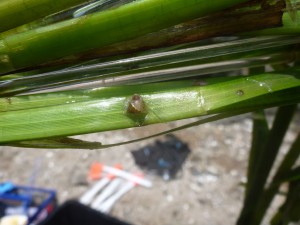 The following day we collected the experiment and found fairly high predation rates, particularly on amphipods. Although I did not spot many fish in my snorkeling adventures, clearly they were lurking in the murky depths of the beds. The visibility was poor, similar to our waters in NC, so I felt right at home.
The following day we collected the experiment and found fairly high predation rates, particularly on amphipods. Although I did not spot many fish in my snorkeling adventures, clearly they were lurking in the murky depths of the beds. The visibility was poor, similar to our waters in NC, so I felt right at home.
I am looking forward to setting up the predator exclusion experiment next week, but for now I am spending my weekend walking around and getting to know this part of Hiroshima. More to come next week…
8000 miles for science!
by Nicole Kollars (ZEN exchange fellow in Northern Japan)
Over 8000 miles is the distance I am estimating that I have travelled in the last 30+ hours from my home in Charleston, South Carolina to Akkeshi, Japan where I will be assisting Dr. Massa Nakaoka and his team with the 2012 ZEN experiment at the northern Japan site. My flight left Charleston at 1430 EST and I arrived safe and sound in Akkeshi around lunchtime… 2 days later!
With working to bring my own research in Charleston to a stopping point before heading to Japan, I did not have time to start packing until 2230 the night before my flight. Even the morning of my departure I was still making the phone calls necessary before leaving the country (banks, utility companies, Grandma) and packing right up to the last minute. Before I knew it my 40 lb backpack (which is larger than I am!) was stuffed into the backseat of my housemate’s car and we were off to the airport. On the drive there I received a call form Pamela telling me my flight to Washington DC was delayed due to weather. Upon arriving at the airport, I spent 45 minutes talking with the man at the ticket counter and learned that you should never underestimate an airline employee who knows how to work the system. First he made sure that I had a reservation on another flight in case I could not make my connecting flight to LA when I arrived in Washington D.C. Next, he had my gigantic backpack checked all the way to Kushiro (my final destination) and he had printed out my boarding passes for my ANA flights to Japan. This was amazing considering I was traveling on two different airlines.
In the end my flight to D.C. only departed 3 minutes late and actually arrived 10 minutes early. Catching my flight to LA was not going to be a problem and I even had time to find a Travelex kiosk so that I could exchange some US dollars to Japanese yen. And I must say, the Japanese banknotes are quite beautiful! With my new currency in hand, I boarded the flight to LA on time and I settled in next to a Buddhist monk heading to Burma and a young woman on her way back to Australia. We were pulling out of the gate and heading for the airstrip when the Captain announced that all flights were grounded until further notice due to severe storms over the Blue Ridge Mountains just west of D.C.. Luckily, Pamela and I anticipated potential delays when booking my flights so the nearly 2-hour standstill on the tarmac was not going to prevent me from catching the plane to Tokyo once I reached LA.
I arrived in LA a little after 2100 PST (travel time thus far: 10 hrs). The process of getting from the domestic flights terminal to the Tom Bradley International terminal (TBIT) was quite the adventure. With the chaos of LAX ground transportation (cars everywhere and incessant honking), I have to admit that when I finally walked into the arrival lobby of TBIT, I was quite overwhelmed. However, the employees at the ANA counter where I had to exchange the boarding passes I received in Charleston with the official ANA boarding passes were helpful and polite. They even gave me a head’s up about customs procedures in Tokyo which was very much appreciated.
I was half-asleep by the time I boarded the plane at 0045 PST (0345 to my US east-coast adjusted body) and I curled-up in my window seat and cannot even remember taking off. I was worried that I wouldn’t be able to sleep on the nearly 11 hr flight to Tokyo, so when I woke up 6 hrs later, I was quite relieved that I wouldn’t be arriving in Japan resembling the waking dead.
The part of the flight that I was awake for was very pleasant. The stewardesses were gracious, the seats comfortable and spacious, and the food amazing. I was anticipating the ANA provided meal ever since I read Matt Whalen’s post about his own experience travelling to Japan and I was not disappointed. There was just enough time to re-read the 2012 ZEN manual for a quick refresher of the science that awaited me in Akkeshi before the plane began its descent into the land of Nihon.
I arrived at the Tokyo Haneda airport a little after 0400 Saturday morning – Japan time (travel time thus far: 25 hrs). My first impression of the airport was that it was incredibly clean, sleek, quiet, and peaceful. I was grateful for this because I was expecting a people-filled, noisy environment of chaos, similar to what I left in Los Angeles. Customs was thankfully painless; I think the gentleman who inspected my bag was amused by the piles of neoprene that I had packed anticipating the cold water of the ZEN field site in Akkeshi. If it wasn’t already obvious that I was a foreigner, I think the slow walking pace and my wide-eyed look would have given me away in an instant as I proceeded to wonder through the airport taking it all in – the signs that I didn’t understand, the new sounds and tones, and the sleek design of practically everything.
I had one more flight from Tokyo to Kushiro before my travels were over. As the plane descended into Kushiro, I was taken back by the beautiful green forests of Hokkaido. Two members of the Nakaoka lab were waiting for me at the airport – Kyosuke-san, a 2nd year master’s student at Hokkaido University, and Kentaro-san, a research fellow with Dr. Nakaoka. It was about an hour drive from Kushiro to Akkeshi through lush wetlands scattered with small farms. We passed a couple of fields of workers stretching out long pieces of the kelp Laminaria to dry. Kentaro-san explained that the algae is harvested from the ocean, but the coast is too foggy for the seaweed to dry effectively so it is transported inland to be laid out in the sun. Seeing the fields filled with these algae reminded me of the economic importance of seaweeds and how algae are used to make so many products we use in the USA and around the world everyday, from ice cream, to toothpaste, to sushi.
We arrived in Akkeshi around lunchtime (travel time thus far: 32 hrs). To reach the marine station, you have to drive through the town of Akkeshi and travel over a long red bridge that marks the separation from Lake Akkeshi (the estuary) and Akkeshi Bay (the sea). As we drove over the bridge I saw the thick eelgrass beds that dominated these waters – I can’t wait to see these plants up close and personal when we set up the ZEN experiment here next week!
After crossing the bridge, we drove down an incredibly steep and curving hill to reach Akkeshi Marine Station. Kyosuke-san saw that I was settled into the dormitory where I will be staying for the next 6 weeks and gave me a tour of the lab. When Kyosuke-san showed me the jars of the ethanol-preserved predators and grazers commonly found in the local eelgrass beds, I was shocked by how giant the caprellid amphipods and isopods are here. They definitely are not that big back home in the Carolinas!
Over 8000 miles and 30+ hours later, I am all settled into Akkeshi on the other side of the world from home. We start the ZEN experiment this next week and I really look forward to the next 6 weeks of giant amphipods and 6 ft (over 2 m) long Zostera blades. I am grateful for the opportunity to be here, the warm welcome I have received, and the adventures that lay ahead.
When I woke up from a very long nap and looked outside my dorm window to the glassy, misty ocean view, with herons flying by and the soft sound of waves lapping the shore, my first thought was how this is all very ZEN. Literally.
Sewing for success
by Caitlin Fikes (VIMS summer 2012 REU student)
Of all the skills I didn’t expect to learn this summer, sewing is definitely top of the list.
As a child, I envied my brothers who were in the Boy Scouts, the American association that teaches young boys and men leadership skills and about the natural world. They got to go hiking and kayaking and learn about animals and the wilderness. I also wanted to make plaster pawprints and carve small wooden boats and learn survival skills, so I decided to try the next best thing, the Girl Scouts. I think my membership in the Girl Scouts lasted for about two months, at most. The boys got to be Bears and Cubs, while we were Brownies and Daisies. And instead of fun skills like archery or campfire-making, in my local troop we were expected to learn cooking and sewing. This was not for me!
It seems ironic that in my pursuit of a historically “masculine” scientific career, I now find myself required to learn what once would have been casually termed a “feminine” skill. Being a scientist, as I recently discovered, also means being a plumber, an engineer, and always a hard worker. Of the many skills needed to construct the equipment for an experiment, here at VIMS sewing is a common requirement. Last week I was taught this skill by a man, our lab manager Paul Richardson, who can sew neater stiches than anyone I know. In science, Paul has remarked, you have to be a Renaissance person with a diverse skillset and an open mind.
What surprised me was not that I had to learn this skill, but that I truly enjoy sewing and apparently have an aptitude for it. After a full day of doing nothing but sewing mesh bags to be used in a field experiment, I was very pleased to see that my lines were getting straighter, and overall I was gaining confidence. I was actually having fun. I reflected that perhaps I should have stayed in Girl Scouts – I might have become a pretty good seamstress by now. Expanding my list of skills is always a good thing, and if not for this summer I might have forever missed out on a skill that I both enjoy and could be good at. Additionally, as a twenty-year-old college student struggling daily to feed myself, I deeply regret not learning how to cook.
Aside from making experimental materials, what other opportunities will I have to use this new needle-and-thread skill? After a quick Google search, I think my next challenge will be to sew my own stuffed animal sea creatures. To the left see one pattern I found online – it looks fairly simple and I firmly believe that you can never own too many cute marine animal paraphernalia.

